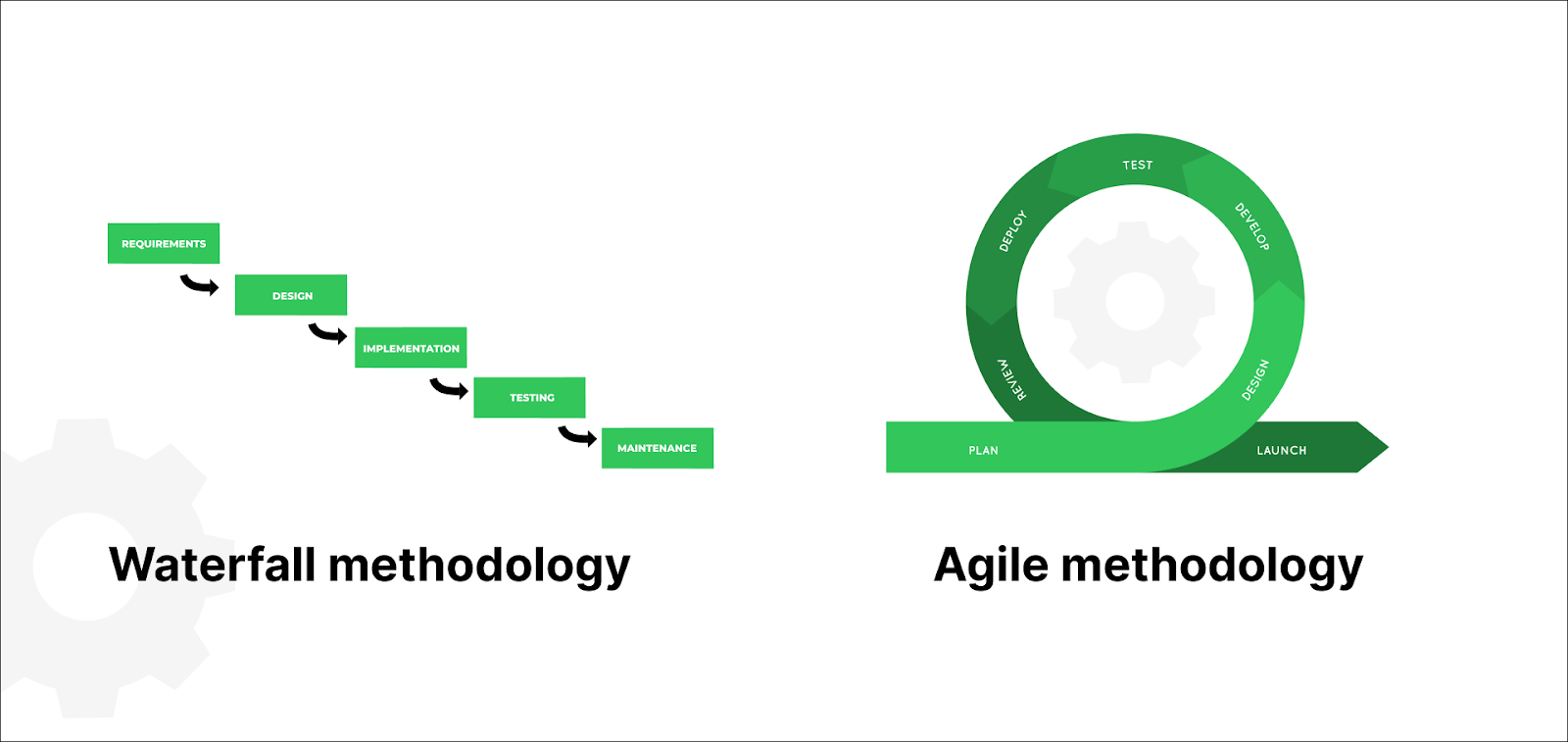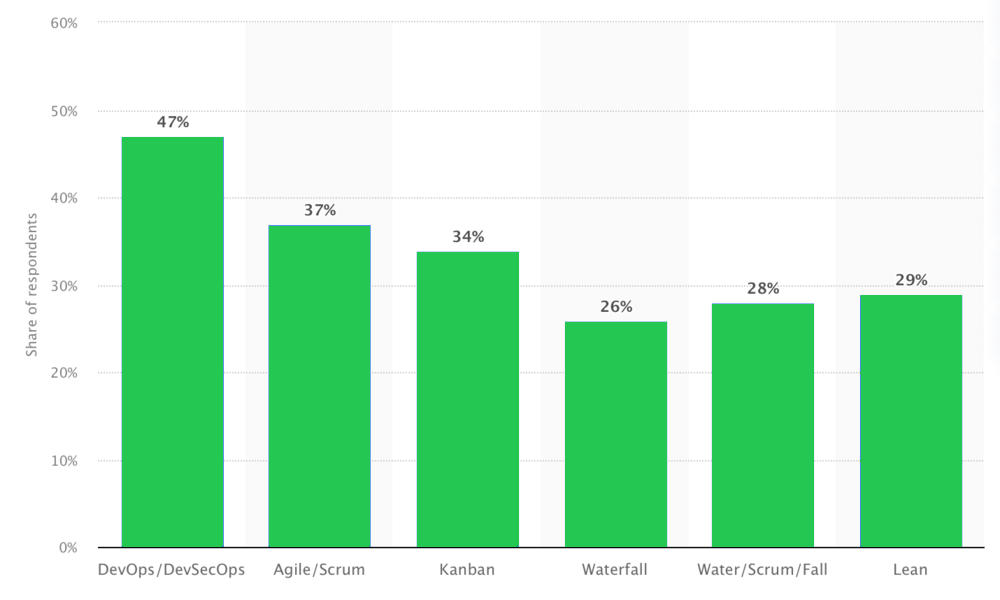What is Agile all about?
Agile software development is an umbrella term for a set of frameworks and practices based on the values and principles expressed in the Manifesto for Agile Software Development.
This methodology is a dynamic and iterative approach to project management that prioritizes collaboration, rapid prototyping, and continuous improvement. Its growing importance derives from its ability to enhance responsiveness to evolving market needs, foster a culture of continuous improvement, and significantly reduce time-to-market for products and services.
Agile is a transformative force across diverse industries, showcasing its adaptability to the unique demands of each sector.
For instance, in healthcare, Agile streamlines processes, fostering nimble responses to regulatory changes and facilitating rapid innovation. For mobile app development, Agile’s iterative approach ensures swift adaptations to dynamic technological landscapes, promoting faster time-to-market and improved user experiences. In the realm of video communications, Agile enhances adaptability to emerging technologies and allows for continuous refinement based on user feedback. Moreover, in web analytics, Agile’s iterative cycles align seamlessly with the pace of data collection, promoting a culture of continuous improvement.
Given the rapid pace of innovation in every industry mentioned, we, at XSoft, consider Agile a fundamental methodology for successful product delivery. Our team works in short, iterative cycles, meaning we can react quickly and implement changes on a continuous basis. This ultimately leads to high-quality software delivered on time and within budget.
Agile values and principles explained
In 2021, a group of people, known as the Agile Alliance, created the Agile Manifesto – a document containing 4 values and 12 principles to be followed by software developers.
The aim of the document was to improve the complex software development processes.
The 4 key values are:
- Individuals and interactions over processes and tools
- Working software over comprehensive documentation
- Customer collaboration over contract negotiation
- Responding to change over following a plan
The 12 principles of Agile that build the foundation of the most popular way to manage projects in digital era:
- Our highest priority is to satisfy the customer through the early and continuous delivery of valuable software.
- Welcome changing requirements, even late in development. Agile processes harness change for the customer’s competitive advantage.
- Deliver working software frequently, from a couple of weeks to a couple of months, with a preference to the shorter timescale.
- Business people and developers must work together daily throughout the project.
- Build projects around motivated individuals. Give them the environment and support they need, and trust them to get the job done.
- The most efficient and effective method of conveying information to and within a development team is face-to-face conversation.
- Working software is the primary measure of progress.
- Agile processes promote sustainable development. The sponsors, developers, and users should maintain a constant pace indefinitely.
- Continuous attention to technical excellence and good design enhances agility.
- Simplicity–the art of maximizing the amount of work not done–is essential.
- The best architectures, requirements, and designs emerge from self-organizing teams.
- At regular intervals, the team reflects on how to become more effective, then tunes and adjusts its behavior accordingly.
Following and implementing Agile values and principles is essential for the success of software development projects in any team.
Here are a few benefits why teams use Agile:
- Increased adaptability: Agile enables quick responses to changing requirements and market conditions, ensuring alignment with evolving needs.
- Quicker delivery times: Iterative development cycles and a focus on delivering working solutions result in faster and more predictable delivery times.
- Enhanced customer satisfaction: Agile’s customer-centric approach, emphasizing continuous collaboration and responsiveness to feedback, leads to higher levels of customer satisfaction.
- Improved team dynamics: Agile principles prioritize communication, collaboration, and a shared sense of ownership, fostering positive team dynamics and morale.
According to digital.ai nearly 70% of software development and delivery teams have adopted agile practices and principles in 2023. Furthermore, a McKinsey survey on agile transformations indicates that 65% of highly successful transformations reported a significant positive influence on financial performance. This emphasizes that Agile methodologies not only contribute to operational excellence but also drive tangible business success.
Agile in Healthcare
In the healthcare industry, Agile implementation encounters unique challenges that demand specialized attention. These challenges include:
- Stringent regulatory compliance
Healthcare operates within a highly regulated environment, with strict compliance requirements imposed by entities such as HIPAA (Health Insurance Portability and Accountability Act). Navigating these regulations while adhering to Agile principles requires a careful balance to ensure both regulatory compliance and agile flexibility.
- Data privacy and security concerns
Agile processes must align with stringent data protection standards to safeguard patient information, posing a unique challenge compared to industries with less sensitive data concerns.
- Accuracy and precision in patient care
The healthcare domain demands a high level of accuracy, precision, and reliability in patient care. Agile methodologies need to accommodate these critical requirements without compromising on the iterative and adaptive nature of Agile development.
Our company adopts an Agile approach in healthcare, emphasizing iterative development to address both regulatory adherence and patient-centric solutions. A notable project in our company is the development of a comprehensive EHR/EMR software system. This system is tailored for healthcare providers, offering efficient management of patient medical records and the automation of clinical workflows. Our Agile methodology ensures continuous improvement and compliance with industry standards and regulations. The iterative nature of our Agile approach enables us to adapt swiftly to regulatory changes, consistently enhancing patient experiences and ensuring the highest standards of compliance.
Agile in Mobile App Development
The mobile app market’s dynamism is driven by the need for rapid development, constant user engagement, and a commitment to continuous iteration.
Our team embraced this dynamic nature, allowing us to deliver successful mobile applications. For instance, consider our mobile dating app developed using React Native.
- Rapid prototyping
Our team efficiently translated user stories into tangible prototypes, enabling stakeholders to provide early feedback. This iterative prototyping process accelerated decision-making and ensured that the final product aligned closely with user expectations.
- Flexible release cycles
Instead of rigid timelines, our team adopted a release schedule that allowed for continuous delivery of features and updates. This flexibility ensured that valuable improvements could be pushed to users promptly, responding to market dynamics and user feedback in real-time.
Agile in Video Communications
In today’s dynamic and interconnected world, there is a growing demand for video communication solutions that offer high quality, scalability, and robust security. As organizations and individuals increasingly rely on video communication for various purposes, meeting these demands has become essential for seamless and effective collaboration.
Here’s how we address these crucial requirements in our Real-Time Communication Application project:
- High-quality video
Our video communication solution prioritizes high-quality visuals and audio to ensure a clear and immersive experience. We leverage cutting-edge video compression technologies and optimize network utilization to deliver high-resolution video content. This commitment to quality enhances user engagement and fosters effective communication.
- Scalability
Scalability is a core consideration in our Agile strategy. Our application is designed to support up to 50 users in a single room, providing a seamless experience even as user numbers grow. Through continuous testing and optimization, we ensure that the application remains robust and performs efficiently, accommodating evolving user demands.
- Security measures
Security is a top priority for our team, especially in real-time communication projects. We implement robust encryption protocols to safeguard data transmission, ensuring that user interactions are secure and private. By staying vigilant to emerging security threats, we proactively enhance the application’s defenses against potential vulnerabilities.
Agile in Web Analytics
The web analytics industry faces several challenges, reflecting the evolving nature of online data and the increasing demand for actionable insights. XSoft has demonstrated a robust approach to web analytics solution development by tailoring Agile methodologies to create a flexible, scalable, and user-centric application.
Here’s how our Agile strategy aligned with the development of the web analytics application:
⇒ Agile Principles for Flexibility
The application’s customizable reporting feature is an evidence to this flexibility, allowing users to tailor reports to their specific business needs. This iterative approach ensures that the application can adapt to evolving user requirements.
⇒ Scalability as a Core Focus
The optimization for scalability and performance improvements showcases a commitment to handling increased data volume and user load. This ensures that the application can grow seamlessly alongside the expanding needs of businesses without compromising performance.
⇒ User-Centric Development
Notable achievements, such as real-time analytics and effective user segmentation, highlight the user-centric focus. These features empower businesses to make swift decisions based on the latest information and conduct more targeted analyses of user behavior.
⇒ Timely updates through iterative development
The successful integration across various digital platforms and the introduction of real-time data processing reflect a commitment to providing timely updates. This ensures that businesses have access to the latest insights and analytics tools across diverse digital channels.
⇒ Data accuracy and security
Data privacy and security, as well as compliance with regulations such as GDPR, are integral components of the application. This ensures that data is handled with the utmost care and aligns with the highest standards of security and regulatory compliance.
Agile vs. Waterfall – what’s the difference and which one to choose?
Besides Agile, Waterfall is a well-known project management methodology. Both of them are popular in software development but each is best suited for different types of projects. The main difference is that Waterfall is a linear system of working that requires the team to complete each project phase before moving on to the next one, while Agile encourages the team to work simultaneously on different phases of the project.

Here are some key differences between Agile and Waterfall:
| Waterfall | Agile | |
| Inception Year | 1970 | 2001 |
| Life Cycle | Linear subsequent model for developing and testing software | Continuous iteration life cycle model for developing and testing software |
| Process | Broken into several phases | Divided into sprints |
| Changes | Changes can be made even after the initial planning is completed | Development requirements cannot be changed once the project development begins |
| Projects | Best suited for projects that are well-defined and require not any changes | Best suited for projects where requirements are expected to change |
| Budget | Fixed | Flexible |
| Testing Plan | Test plan is reviewed after each sprint | Test plan is rarely discussed during the test phase |
| Test | The “Testing” is done after the “Build” step | Testing occurs with software development simultaneously |
According to a report by Statista, 37% of respondents use Agile methodology, while 26% use Waterfall methodology:

XSoft’s Expertise
Our company cultivates a dynamic Agile environment that promotes collaboration, adaptability, and a relentless focus on delivering value to stakeholders. The emphasis on continuous improvement ensures that Agile practices evolve in alignment with the changing needs of projects and the broader business context.
Our team is carefully composed to be cross-functional, focusing on collaboration and iterative development. We have skilled software developers, delivery managers, UX/UI designers, quality assurance specialists and a Scrum Master with extensive technical command in developing custom solutions across various industries.
Sprint planning involves iterative breakdowns of projects, emphasizing collaborative prioritization for effective task management.
Stakeholder engagement is continuous, involving regular communication, sprint reviews, and inclusive decision-making, ensuring alignment with business goals.
Feedback mechanisms, both internal and from clients/users, are integral for continuous improvement, with retrospectives providing opportunities for reflection and adaptation.
Final Thoughts
The proven flexibility and success of Agile methodologies across diverse industries, coupled with our company’s specialized approach, underscore the transformative potential of this methodology.
XSoft team can provide industry-specific strategies, ensuring a seamless integration of Agile principles tailored to the unique demands of your business. Make the strategic choice to embrace Agile, and work with our team for a customized approach toward your project.

